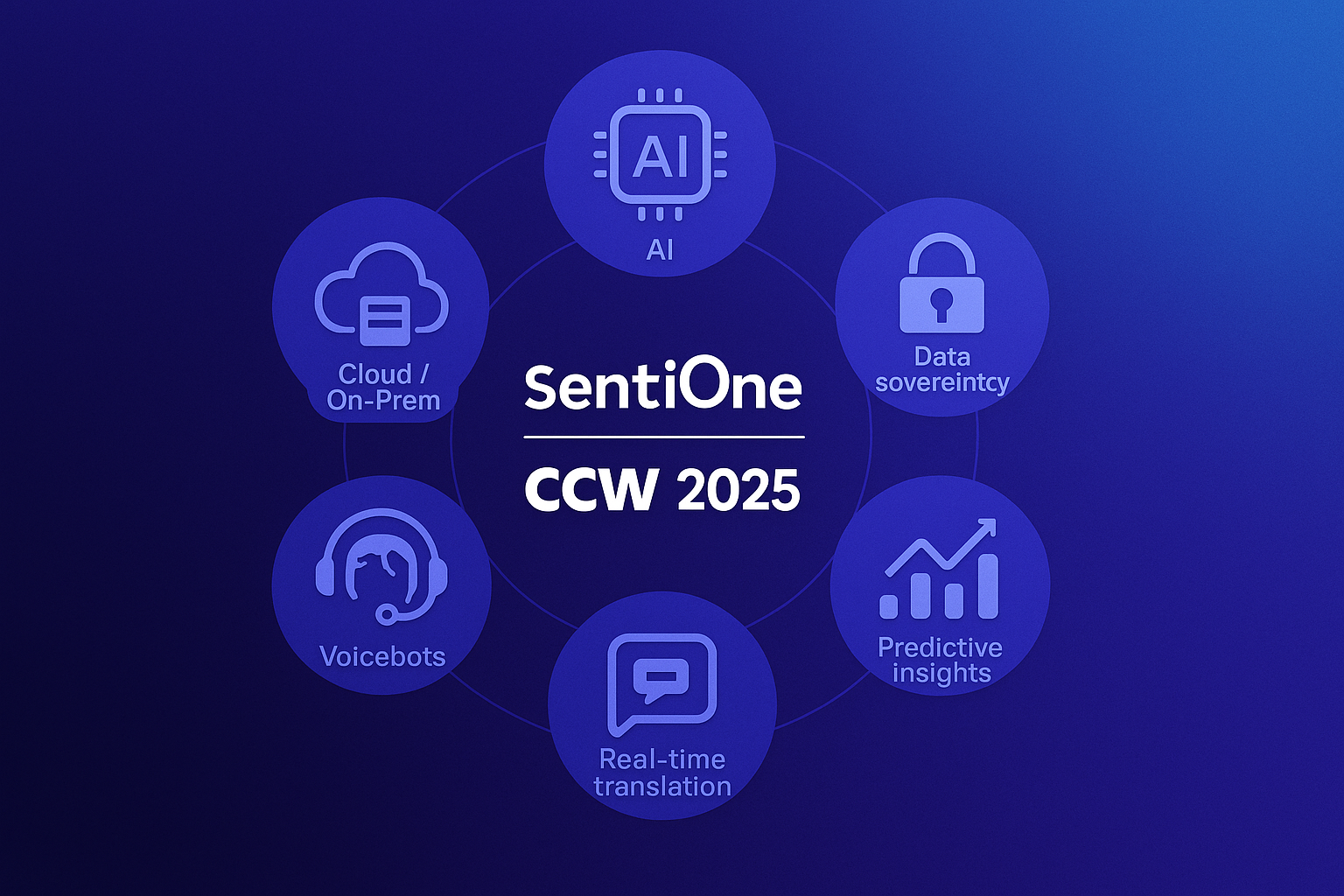Contact Center Trends 2025 – Key Takeaways from CCW Berlin
Introduction
CCW 2025 (Call Center World) in Berlin is the most significant European event for the Contact Center industry, bringing together customer service, technology, and business leaders. This year’s edition took place at the Estrel Hotel, featuring 4 large exhibition halls packed with industry vendors, and a parallel 4-day conference program with 3 days of trade show, over 280 expert presentations, and 50 hours of networking.
Our team was present on-site, engaging with exhibitors, attending sessions, and closely monitoring the technological and business directions shaping the future of customer service.
Market Directions
AI-Powered Automation and the Rise of LLMs
One of the most prominent trends is the widespread adoption of AI-driven automation, powered by Large Language Models (LLMs). These advanced models are now embedded in chatbots, voicebots, agent assist tools, real-time transcription, and more. They understand context and intent, enabling far more natural and intelligent interactions.
LLMs are not just replacing repetitive tasks—they’re becoming real-time copilots for human agents, offering suggestions, retrieving knowledge base entries, and guiding the conversation. The model of “Human + AI” is gaining traction, emphasizing collaboration rather than replacement.
Breaking Language Barriers in Customer Service
The second major shift is the emergence of real-time translation technologies. These allow agents to communicate with customers in any language without being multilingual themselves. As language becomes a non-issue, companies can centralize support operations while maintaining high-quality service across markets. This opens up new opportunities for global efficiency without sacrificing local experience.
Data Sovereignty: Cloud vs On-Premises
Geopolitical concerns are reshaping how companies think about data hosting. The Cloud vs On-Premises debate is back, fueled by uncertainty around transatlantic data transfers and regulations like the U.S. CLOUD Act. European companies are increasingly seeking EU-based vendors or hybrid approaches to ensure full GDPR compliance and maintain control over sensitive customer data. “Digital sovereignty” was a recurring theme at CCW, as companies weigh innovation against regulatory and reputational risk.
Tech Highlights
Natural-Sounding Voicebots: ASR and TTS Evolution
Automated Speech Recognition (ASR) and Text-to-Speech (TTS) technologies have reached a new level of maturity. Voicebots today sound remarkably natural, thanks to neural TTS engines, and they understand speech even in noisy or accented environments.
The result: bots that can handle phone calls independently, 24/7, sounding friendly and professional. These technologies are unlocking scalable, human-like service experiences and freeing up human agents for more complex interactions.
AI-Driven Speech Analysis and Scorecards
Speech analytics tools powered by AI can now analyze 100% of customer interactions in real time. They detect not just keywords but also tone, compliance with scripts, and emotional cues. Automatically generated AI scorecards assess agent performance, enabling managers to deliver faster, data-driven coaching.
These systems improve service consistency and help identify both top performers and coaching opportunities. They’re also valuable for compliance and reducing reputational risks.
Real-Time Agent Assist
AI copilots are transforming live agent support. These systems listen in real time, understand the ongoing conversation, and suggest next steps, articles, or actions based on context. They even detect customer sentiment and provide de-escalation prompts when needed.
This significantly reduces handling time and boosts agent confidence, particularly for junior staff. It also improves first contact resolution and customer satisfaction by delivering relevant answers immediately.
UI/UX: A Growing Concern
While functionality is increasing, user experience (UX) is lagging behind. Many platforms are overloaded with features, making them complex to navigate. This hurts agent efficiency and slows adoption.
Vendors are starting to respond with cleaner interfaces, customizable dashboards, and simplified workflows. Still, the market is polarized—some tools shine in usability, others are clearly “built by engineers for engineers.” As tech gets more powerful, usability must keep pace.
Risks and Challenges
AI Liability: The Air Canada Case
The risks of AI in customer service are real. A notable example is the Air Canada chatbot case, where a bot gave misleading information about a fare discount. When the company refused to honor the chatbot’s response, the customer took them to court—and won.
The court ruled that the company is responsible for what its AI says, regardless of intent or disclaimers. This highlights the need for strict validation, content control, and human oversight in AI deployments. Businesses can’t hide behind the “autonomy” of their bots.
Europe’s Innovation Gap
At CCW, it became clear that Europe still heavily relies on non-European technologies in the Contact Center space. Major platforms are American or Asian, with few local alternatives. This limits data sovereignty and customization options.
There’s a pressing need to support local AI and CX startups, promote homegrown technologies, and encourage companies to explore EU-based vendors. Otherwise, Europe risks falling further behind in a space where innovation defines competitiveness.
Our Perspective
At our company, we’ve embraced AI as a tool to empower, not replace, people. Our philosophy is human-first: AI augments agents, ensures faster service, and improves accuracy—but always under human oversight.
We’re also committed to building and promoting our own NLU technology, developed entirely in Europe. It’s designed to comply with GDPR, address real market needs, and offer a serious alternative to big tech tools. We’re proud to be part of the “Made in EU” movement.
Looking ahead, we’ll continue investing in intelligent automation, focusing on transparency, reliability, and trust. Our goal is not just to follow trends but to shape them—always with our clients’ and end users’ experience in mind.



